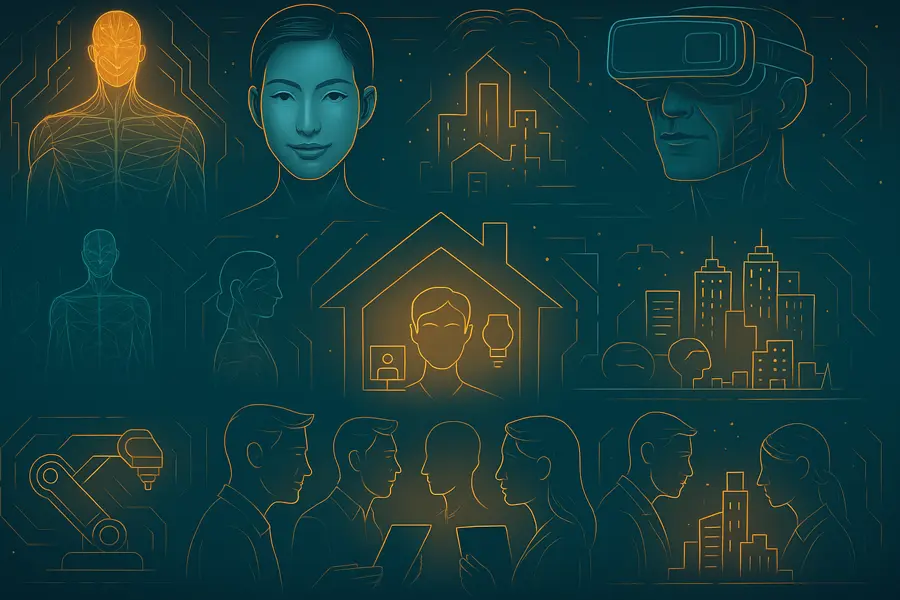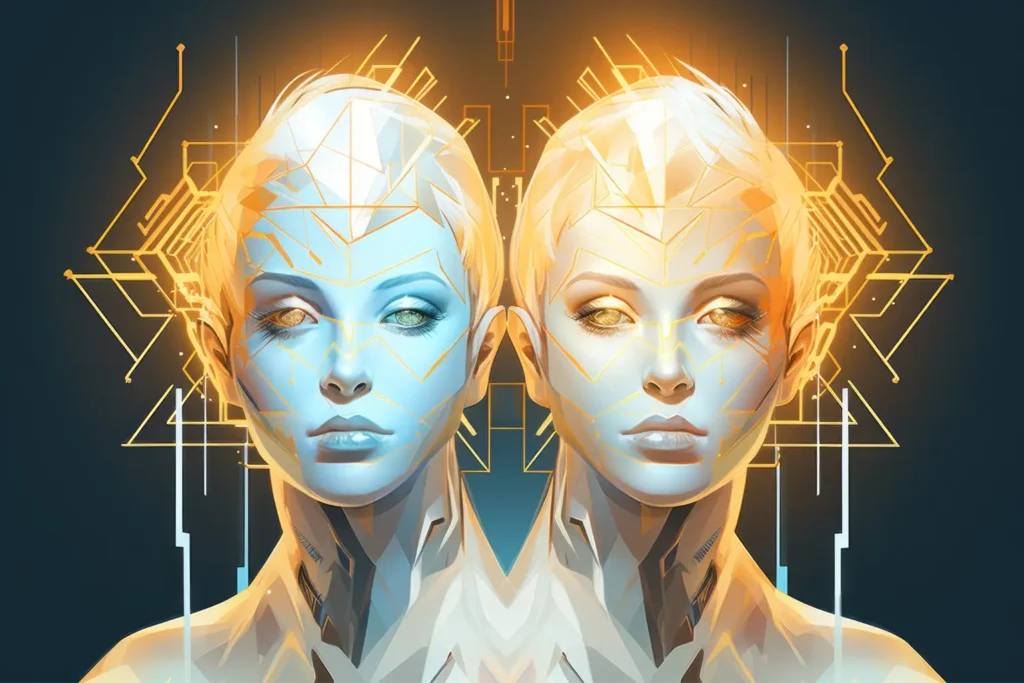Imagine if you could create a digital copy of something real — like a machine, a person, or even a city — and use it to test ideas, fix problems, or see what might happen in the future. That’s what a digital twin does. It’s a virtual version of something physical, and it’s changing how businesses work.
Companies use digital twins to save money, improve performance, and make smarter decisions. Whether it’s a factory, a hospital, or a concert stage, digital twins are being used in more places than ever. In this article, we’ll break down what they are, how they work, where they’re used today, and what the future of digital twins might look like.
What is a Digital Twin?
A digital twin is a virtual version of something real — like a person, product, machine, or place — that shows how the real thing is doing right now. Think of it as a “living” digital copy that updates in real time and helps you see problems, test ideas, or understand how things work without touching the real version.
For example, a digital twin could:
- Help a company test how a new product will perform before building it
- Show how a machine is running — and alert you before it breaks
- Act as a virtual assistant or live avatar in customer service or sales
The 3 Key Components of a Digital Twin:
- The Physical Object or Person: This is the real-world version — a machine, system, human, or building.
- The Digital Model: A computer-generated copy that looks and behaves like the original. This could be a 3D model, a live portrait, or a simulation.
- Real-Time Data Connection: Sensors, devices, or software constantly send updates from the real object to the digital one, so it always shows what’s happening right now.
Together, these components make the digital twin smart, responsive, and useful. It’s not just a static image — it’s alive with information and can help predict what’s coming next. This foundation is key to unlocking the potential of digital twins in the modern business landscape.
How Digital Twins Are Transforming Business Strategy
Digital twins are helping businesses work smarter — not harder. By creating a live, virtual version of a product, system, or even a person, companies can test ideas, catch problems early, and improve performance without wasting time or money.
Instead of guessing what might go wrong, businesses can now see it happening in real time and make changes before it becomes a costly issue. That’s why digital twins are being used in everything from car factories and hospitals to real estate, retail, and marketing.
The future of digital twin technology lies in its ability to enhance decision-making, reduce risk, and simulate future scenarios. Here’s how they’re changing the game:
- Save money by spotting problems early and reducing downtime
- Speed up innovation by testing new ideas virtually before investing in real ones
- Improve customer experiences with smart, personalized digital tools
- Train staff safely in digital environments before they work on real systems
- Stay competitive by using real-time data to make smarter business decisions
With platforms like eSelf.ai, it’s now possible to create a digital twin of yourself — not just of machines or buildings. These AI-powered live portraits look, speak, and act like you, and can represent you in:
- Video calls
- Customer service chats
- Sales outreach
- Onboarding or training sessions
Your digital twin can match your tone, language, and brand, making it a powerful tool for businesses that want to scale personalized communication — without hiring more staff or sacrificing quality.
In fact, these digital humans transforming business interaction are setting a new standard for how brands connect with customers across digital platforms.
In short, digital twins aren’t just about technology — they’re becoming a strategic advantage that helps businesses do more with less, while staying human at the core.
Industry Snapshot: Where Digital Twins Are Used Today
Across industries, digital twins are delivering real-time visibility, smarter automation, and predictive insights. The future scope of digital twin technology is broad and rapidly expanding. And here is where digital twins can be used in:
- Manufacturing – to test and improve machines and factories,
- Healthcare – to model patient treatment and plan surgeries,
- Smart cities – to manage traffic, air quality, and energy,
- Real estate – to simulate building layouts or guide virtual tours,
- Entertainment – to recreate performers as lifelike digital versions,
- Marketing – with digital humans that speak, react, and represent your brand online,
- Customer support – with AI-powered avatars that handle live chats or FAQs 24/7.
Use Cases: How Industries Are Leveraging Digital Twins

Real-World Examples of Digital Twins in Manufacturing
- General Electric (GE) – Creates digital twins of jet engines to track real-time data like temperature and pressure, predicting failures early and cutting maintenance costs.
- Siemens – Simulates production lines in “smart factories” like their Amberg facility to test changes virtually, reducing downtime and boosting efficiency.
- Tesla – Uses digital twins for both vehicles and production lines to monitor real-world performance and improve over-the-air software updates and automation.
Real-World Example of Using Digital Twins in Healthcare
- Siemens Healthineers – Builds digital twins of organs like the heart to simulate surgeries using patient-specific data, improving outcomes and reducing risks.
- Dassault Systèmes – The Living Heart Project simulates human hearts for testing surgeries, drug impacts, and medical devices, FDA-accepted for modeling.
- Philips – Creates hospital-level digital twins to manage ICU workflows, optimize bed use, and improve hospital operations, especially during the COVID-19 crisis.
Examples of Performers and Singers Using Digital Twin Technology
- ABBA Voyage – ABBA performs via hyper-realistic digital avatars, created using motion capture of the band to simulate live 1970s concerts.
- Whitney Houston Hologram Tour – Features a holographic twin of Whitney performing live on stage, pushing early conversational capabilities.
- James Dean Digital Twin – A CGI twin of James Dean stars in a new movie decades after his death, showing how digital twins could reshape acting.
This is one of the most famous and groundbreaking uses of digital twins in live entertainment.
Real-World Example of Using Digital Twins in Real Estate and Architecture
- City of Singapore – Virtual Singapore models entire neighborhoods to simulate airflow, traffic, and energy use before making city planning decisions.
- Willow at Hudson Yards – Integrates real-time building data (lighting, HVAC, security) into unified digital twins to improve tenant experience and lower costs.
- Microsoft & Bentley – Use Azure Digital Twins to manage building lifecycles, from design to energy consumption forecasting.
- Helsinki 3D+ – Maps Helsinki’s historical and future buildings to simulate growth, optimize solar access, and plan urban sustainability.
Real-World Example of Using Digital Twins in Aerospace and Defense
- NASA – Simulates spacecraft systems and mission environments to predict maintenance needs and optimize designs before launches.
- Boeing – Uses aircraft digital twins for lifecycle management, monitoring real-time sensor data to improve maintenance and safety.
- U.S. Air Force – Monitors aging aircraft like the F-35 and B-1 bombers with IoT-connected twins, reducing unexpected repairs and extending service life.
Real-World Example of Using Digital Twins in Finance and Insurance
- Ping An Insurance – Models customer behavior to offer dynamic insurance pricing, fraud detection, and preventive health advice.
- KPMG – Creates financial enterprise twins for real-time business simulations, helping CFOs plan for M&A, disruptions, or regulation changes.
- Allstate – Uses an AI virtual assistant (“Able”) to support business insurance agents, speeding up customer service and reducing workload.
Real-World Examples of Using Digital Twins of People in Business Applications
- Accenture – Develops employee digital twins to optimize workforce training, role matching, and performance improvements.
- BMW – Simulates human operators inside smart factories to enhance ergonomics, safety, and production line design.
- Deloitte – Explores executive digital twins for leadership continuity, media communication, and decision simulation.
- Infosys – Uses virtual onboarding agents modeled after real HR staff to streamline and personalize new employee onboarding.
- Synthesia – Creates AI video avatars of employees for personalized communication, training, and customer engagement across multiple languages.
10 Future Trends of Digital Twins

As adoption grows, we’re seeing the emergence of exciting future trends of digital twin technology across multiple sectors. From AI-powered avatars to societal modeling, these future uses of digital twins are reshaping how we think about innovation.
1. Smarter, Self-Updating Twins
Trend: Future digital twins will monitor themselves, learn from data, and adjust without human input.
Industry Application: Used in smart factories to reduce downtime and automate process optimization.
2. AI-Powered Human Avatars
Trend: Digital twins of people will act as assistants, trainers, and representatives.
Industry Application: In customer service and marketing, tools like eSelf.ai create lifelike AI video avatars for calls, onboarding, and support.
3. Twin-as-a-Service (TaaS)
Trend: Companies won’t need to build their own twins — they’ll subscribe to them like cloud software.
Industry Application: Helpful for startups, SMEs, or businesses without IT teams to launch digital twins quickly.
4. Genomic & Biological Twins
Trend: Human body replicas will model health risks and simulate treatments.
Industry Application: In healthcare, doctors will use personal digital twins to tailor surgeries, predict disease, and reduce side effects.
5. Smart Homes with Living Twins
Trend: Your home will have a digital twin that knows your habits and automates maintenance.
Industry Application: In real estate and consumer tech, twins will manage appliances, energy, and security.
6. Immersive Twins in the Metaverse
Trend: Twins will live inside virtual environments for training, testing, or collaboration.
Industry Application: In education and remote work, employees can train or meet inside virtual twin simulations.
7. Interconnected Ecosystems
Trend: Digital twins across a supply chain or city will “talk” to each other in real time.
Industry Application: In logistics and urban planning, interconnected twins will optimize deliveries, traffic, and utilities.
8. Digital Twins for Job Training
Trend: Workers will train using digital replicas of themselves and their tasks.
Industry Application: In HR and defense, simulations will reduce training time and improve performance under pressure.
9. Personalized Education with Learning Twins
Trend: Students will have learning twins that adapt to their pace and style.
Industry Application: In education, AI tutors will support students 1-on-1, while providing insights to teachers and parents.
10. Policy Simulation & Societal Modeling
Trend: Governments will test ideas with digital versions of entire communities.
Industry Application: In public policy, leaders will simulate infrastructure changes, social programs, or emergency responses before implementing them.
What’s Powering the Next Generation of Digital Twins
These big ideas wouldn’t work without powerful technology. Here’s what’s behind the magic:
- Artificial Intelligence (AI): Teaches digital twins how to think, learn, and react.
- Smart Sensors: Collect data from machines, cities, or people.
- Fast Internet (5G): Helps twins update instantly.
- Cloud Services: Stores the huge amount of data digital twins use.
- Virtual Reality (VR) & Augmented Reality (AR): Lets people walk through or interact with twins in real time.
- Blockchain: Keeps data secure and easy to track.
These tools help digital twins become smarter, faster, and more useful than ever — and they’re at the heart of the future of digital twin systems that support everything from cities to personal assistants..
Shape the Future of Your Business with Digital Twins
Digital twins aren’t science fiction anymore — they’re here, and they’re helping companies of all sizes. Whether you want to improve a product, train your team, or connect with customers in new ways, a digital twin gives you the tools to do it.
Platforms like eSelf.ai let businesses create AI Digital Twins — digital versions of real people who can speak, interact, and work for your brand. It’s fast, affordable, and real enough to feel human.
The future of business is digital — and it starts with your future digital twin. Embracing the potential of digital twin technology today means being ready for what’s next.
Common Questions About the Future of Digital Twins
What industries will benefit most from digital twins?
Manufacturing, healthcare, aerospace, smart cities, and entertainment are seeing the biggest impact right now.
How are digital twins evolving with AI?
AI helps digital twins learn from data, make decisions, and improve over time.
What’s the difference between a simulation and a digital twin?
A simulation is a one-time test. A digital twin is always connected and updates in real time.
Are digital twins the future?
Yes — they’re becoming essential for business innovation and digital transformation.
What is the potential of digital twins?
They can improve products, reduce costs, help with training, and create better customer experiences.
Do digital twins use AI?
Yes — most advanced digital twins are powered by AI to understand and adapt.
Why will digital twins be a backbone of the industry in the future?
Because they give real-time insights, reduce risk, and make smart planning possible.
What is the growth rate of the digital twin market?
It’s growing very fast — from about $10B in 2023 to over $110B by 2030.
Will digital twins revolutionize healthcare?
Yes — they’ll help doctors test treatments safely and give patients better care.
What is the forecast for digital twins?
The future looks bright. More industries are investing in them, and the technology keeps improving.
